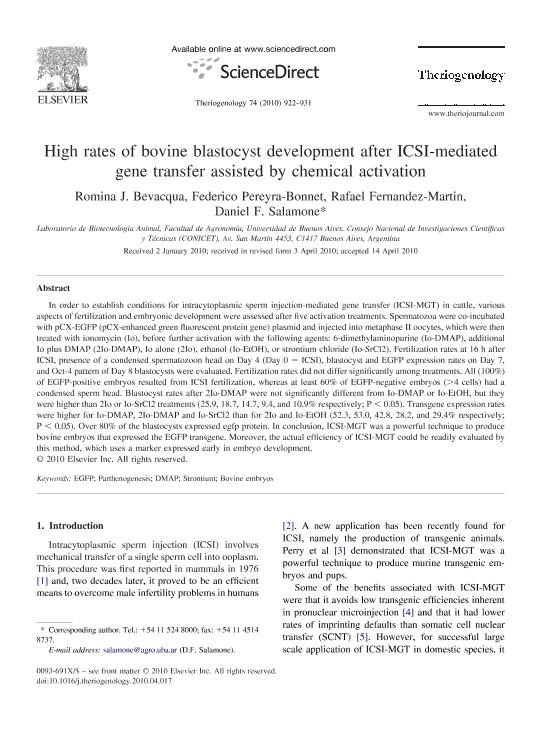Mostrar el registro sencillo del ítem
dc.contributor.author
Bevacqua, Romina Jimena

dc.contributor.author
Pereyra Bonnet, Federico Alberto

dc.contributor.author
Fernandez Martin, Rafael
dc.contributor.author
Salamone, Daniel Felipe

dc.date.available
2017-05-09T21:12:16Z
dc.date.issued
2010-10
dc.identifier.citation
Bevacqua, Romina Jimena; Pereyra Bonnet, Federico Alberto; Fernandez Martin, Rafael; Salamone, Daniel Felipe; High rates of bovine blastocyst development after ICSI-mediated gene transfer assisted by chemical activation; Elsevier Science Inc; Theriogenology; 74; 6; 10-2010; 922-931
dc.identifier.issn
0093-691X
dc.identifier.uri
http://hdl.handle.net/11336/16191
dc.description.abstract
In order to establish conditions for intracytoplasmic sperm injection-mediated gene transfer (ICSI-MGT) in cattle, various aspects of fertilization and embryonic development were assessed after five activation treatments. Spermatozoa were co-incubated with pCX-EGFP (pCX-enhanced green fluorescent protein gene) plasmid and injected into metaphase II oocytes, which were then treated with ionomycin (Io), before further activation with the following agents: 6-dimethylaminopurine (Io-DMAP), additional Io plus DMAP (2Io-DMAP), Io alone (2Io), ethanol (Io-EtOH), or strontium chloride (Io-SrCl2). Fertilization rates at 16 h after ICSI, presence of a condensed spermatozoon head on Day 4 (Day 0 = ICSI), blastocyst and EGFP expression rates on Day 7, and Oct-4 pattern of Day 8 blastocysts were evaluated. Fertilization rates did not differ significantly among treatments. All (100%) of EGFP-positive embryos resulted from ICSI fertilization, whereas at least 60% of EGFP-negative embryos (>4 cells) had a condensed sperm head. Blastocyst rates after 2Io-DMAP were not significantly different from Io-DMAP or Io-EtOH, but they were higher than 2Io or Io-SrCl2 treatments (25.9, 18.7, 14.7, 9.4, and 10.9% respectively; P < 0.05). Transgene expression rates were higher for Io-DMAP, 2Io-DMAP and Io-SrCl2 than for 2Io and Io-EtOH (52.3, 53.0, 42.8, 28.2, and 29.4% respectively; P < 0.05). Over 80% of the blastocysts expressed egfp protein. In conclusion, ICSI-MGT was a powerful technique to produce bovine embryos that expressed the EGFP transgene. Moreover, the actual efficiency of ICSI-MGT could be readily evaluated by this method, which uses a marker expressed early in embryo development.
dc.format
application/pdf
dc.language.iso
eng
dc.publisher
Elsevier Science Inc

dc.rights
info:eu-repo/semantics/openAccess
dc.rights.uri
https://creativecommons.org/licenses/by-nc-nd/2.5/ar/
dc.subject
Genetic Modification
dc.subject
Embryo Cultured
dc.subject
Explants Cells
dc.subject
Intracytoplasmic Sperm Injection
dc.subject.classification
Tecnología GM, clonación de ganado, selección asistida, diagnósticos, tecnología de producción de biomasa, etc.

dc.subject.classification
Biotecnología Agropecuaria

dc.subject.classification
CIENCIAS AGRÍCOLAS

dc.title
High rates of bovine blastocyst development after ICSI-mediated gene transfer assisted by chemical activation
dc.type
info:eu-repo/semantics/article
dc.type
info:ar-repo/semantics/artículo
dc.type
info:eu-repo/semantics/publishedVersion
dc.date.updated
2017-05-08T21:19:44Z
dc.journal.volume
74
dc.journal.number
6
dc.journal.pagination
922-931
dc.journal.pais
Estados Unidos

dc.journal.ciudad
Nueva York
dc.description.fil
Fil: Bevacqua, Romina Jimena. Universidad de Buenos Aires. Facultad de Agronomía. Pabellón de Zootecnica. Laboratorio de Biotecnología Animal; Argentina. Consejo Nacional de Investigaciones Científicas y Técnicas; Argentina
dc.description.fil
Fil: Pereyra Bonnet, Federico Alberto. Universidad de Buenos Aires. Facultad de Agronomía. Pabellón de Zootecnica. Laboratorio de Biotecnología Animal; Argentina. Consejo Nacional de Investigaciones Científicas y Técnicas; Argentina
dc.description.fil
Fil: Fernandez Martin, Rafael. Universidad de Buenos Aires. Facultad de Agronomía. Pabellón de Zootecnica. Laboratorio de Biotecnología Animal; Argentina
dc.description.fil
Fil: Salamone, Daniel Felipe. Universidad de Buenos Aires. Facultad de Agronomía. Pabellón de Zootecnica. Laboratorio de Biotecnología Animal; Argentina. Consejo Nacional de Investigaciones Científicas y Técnicas; Argentina
dc.journal.title
Theriogenology

dc.relation.alternativeid
info:eu-repo/semantics/altIdentifier/doi/http://dx.doi.org/10.1016/j.theriogenology.2010.04.017
dc.relation.alternativeid
info:eu-repo/semantics/altIdentifier/url/http://www.sciencedirect.com/science/article/pii/S0093691X10002244
Archivos asociados
